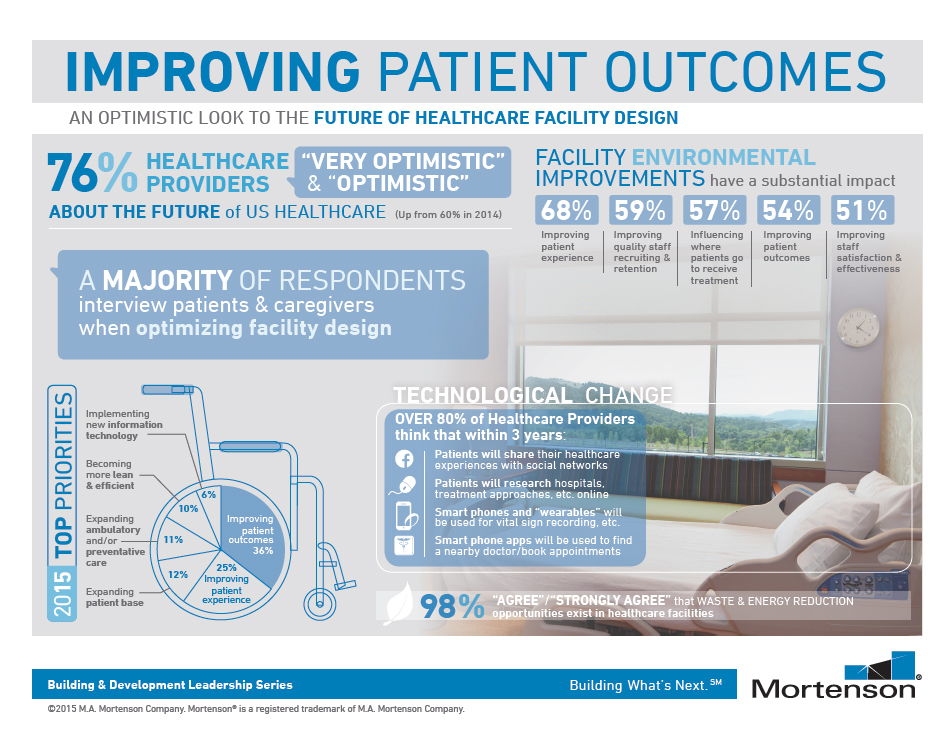Despite overall optimism in healthcare, support for the Affordable Care Act (ACA) has lessened, according to a study from Mortenson.
Nearly eight out of 10 healthcare providers feel that legislation needs significant changes or revisions. The 2015 Mortenson Healthcare Industry Study found that only one-third of providers think that the ACA would lower the per-patient cost of healthcare.
But, providers are confident in advances in facility design, IT, waste and energy reduction, and environmental improvements, and they believe that transparency and patients’ concern in their own wellness will improve the sector as a whole. The study says that 76% of healthcare providers feel “very optimistic” or “optimistic” about the future of healthcare.
The report also found that providers predict that virtual care will become more common, and that providers link physical healthcare facilities and environments with patient outcomes.
"The healthcare market is still in the process of adapting to a new normal," said Bob Nartonis, SVP and National Healthcare Market Leader at Mortenson, in a statement. "There are several challenging dynamics facing healthcare service providers today but they are optimistic as a whole. We are encouraged to see healthcare facility design, interest in the patient experience, and changes in technology continuing to drive innovation in the market."
The full report is available here.

Related Stories
Healthcare Facilities | Feb 7, 2017
Microhospitals: Healthcare's newest patient access point
Microhospitals are acute care facilities that are smaller than the typical acute care hospital. They leave complex surgeries to the big guys, but are larger and provide more comprehensive services than the typical urgent care or outpatient center.
Healthcare Facilities | Feb 6, 2017
NYC cancer hospital rises to the occasion
A recent analysis of patient volumes showed that Memorial Sloan Kettering Cancer Center would run out of space for new construction at its Upper East Side campus in Manhattan in just a few years.
Healthcare Facilities | Feb 3, 2017
Urgent care centers: True pioneers of retail healthcare delivery
Hospitals, either individually or in joint ventures, run 37% of U.S. urgent care centers.
Healthcare Facilities | Jan 19, 2017
A survey challenges the efficacy of decentralized nurses station design
The Institute of Health + Wellness Design at the University of Kansas raised questions after reviewing a hospital’s renovated orthopedic unit.
Healthcare Facilities | Dec 22, 2016
Has ‘green’ delivered on its promise to the healthcare sector?
As we approach the end of the second decade of LEED, the financial costs and benefits of going green are well documented, write CBRE's Lee Williams and Steve Higgs.
Healthcare Facilities | Dec 13, 2016
How healthcare systems can reduce financial risk with developer-owned hospitals
When entering a new market, the financial risk can be magnified to the point that the investment – although critical to a system’s future – becomes unpalatable to a governing board.
Sponsored | Flooring | Dec 7, 2016
Reading Hospital expansion project saves two months in construction schedule thanks to nora nTx
Construction delays are common with projects as large as the $354 million Reading Hospital expansion. Maybe that’s why construction manager Jeff Hutwelker, project executive with LF Driscoll Co., LLC, was so pleased with his nora® experience. By Hutwelker’s estimates, nora nTx saved approximately two months in his construction schedule.
Healthcare Facilities | Nov 30, 2016
Utilizing real estate to build physician networks
How hospitals can partner with their doctors to build an ambulatory network.
Healthcare Facilities | Nov 10, 2016
Prescription for success: Managing technology in the design of healthcare facilities
While the benefits of intelligently deployed technology are abundantly clear to both designers and healthcare end-users, it’s no simple task to manage the integration of technology into a building program.
Public Health Labs | Nov 3, 2016
Cutting-edge microscope facility opens on UMass Medical’s campus
Design and construction met rigorous requirements for sound, vibration, and temperature controls.















